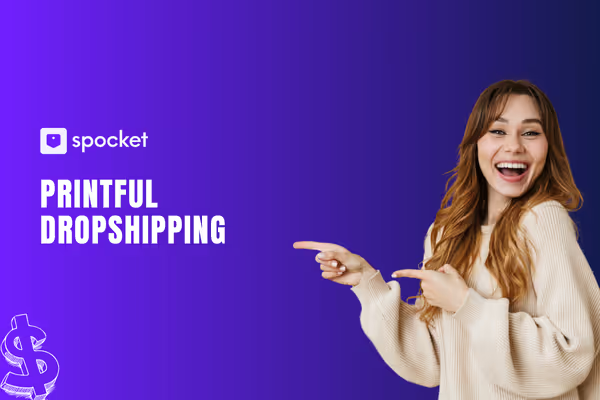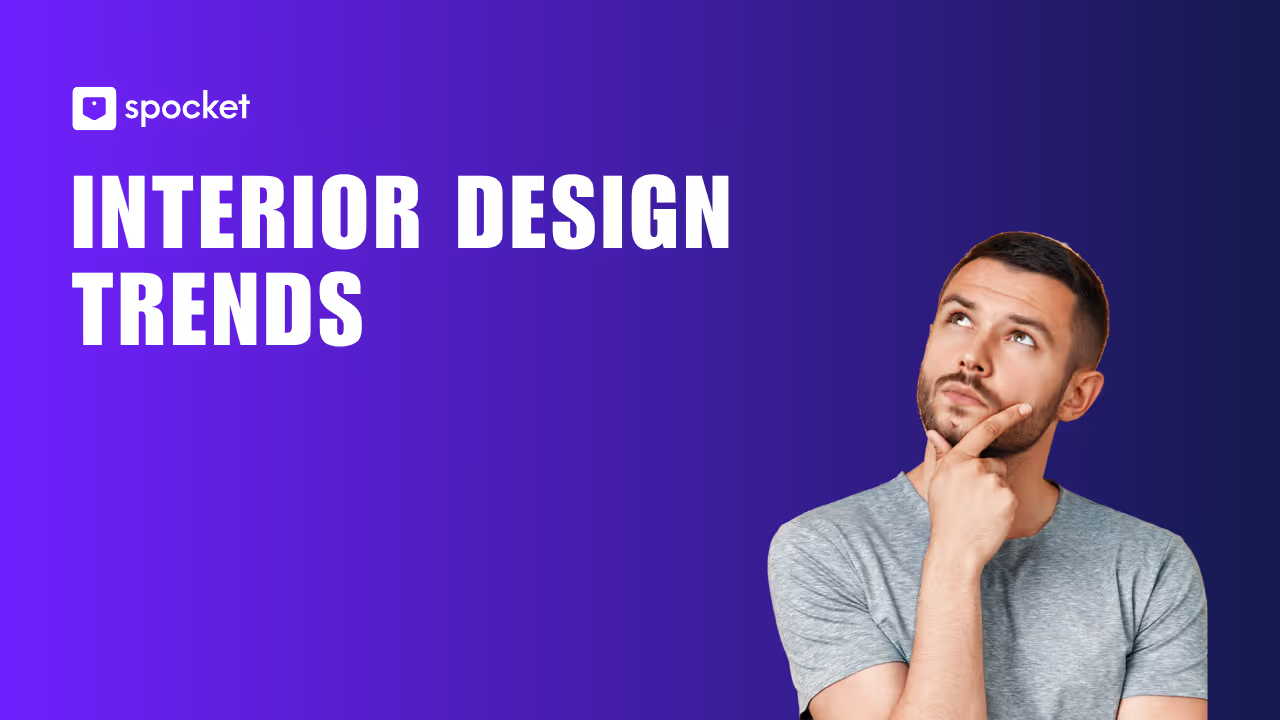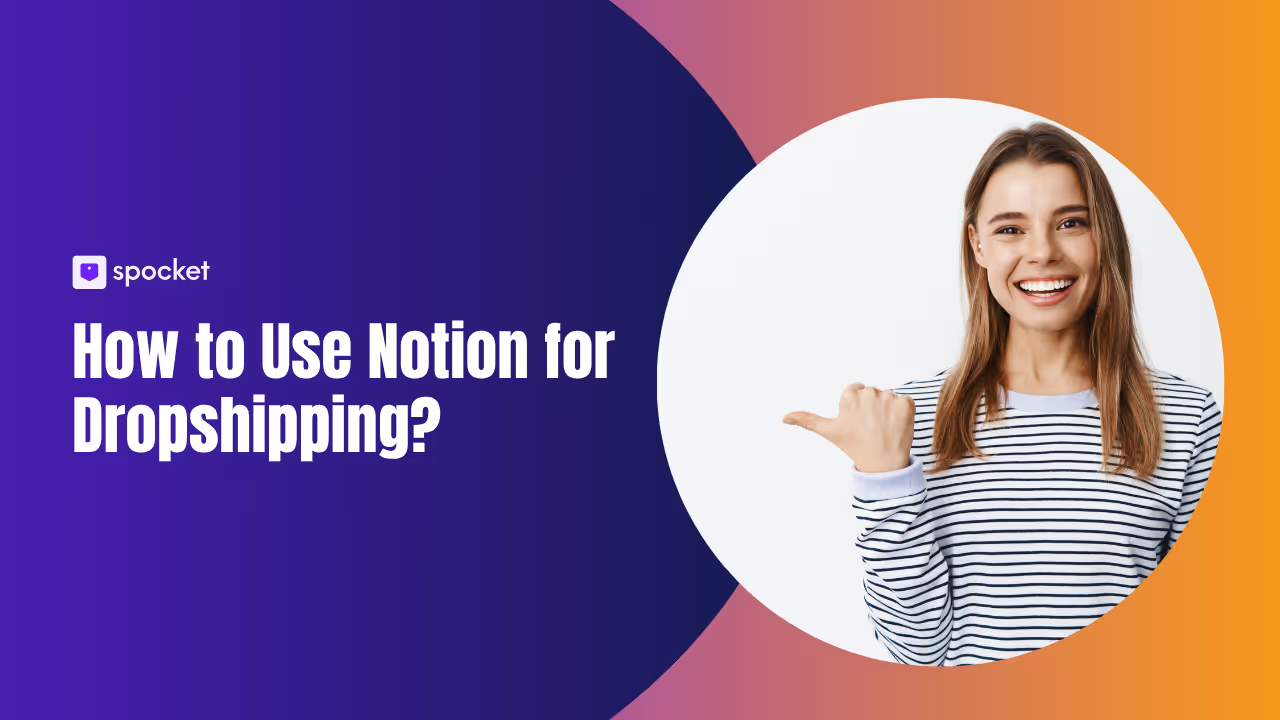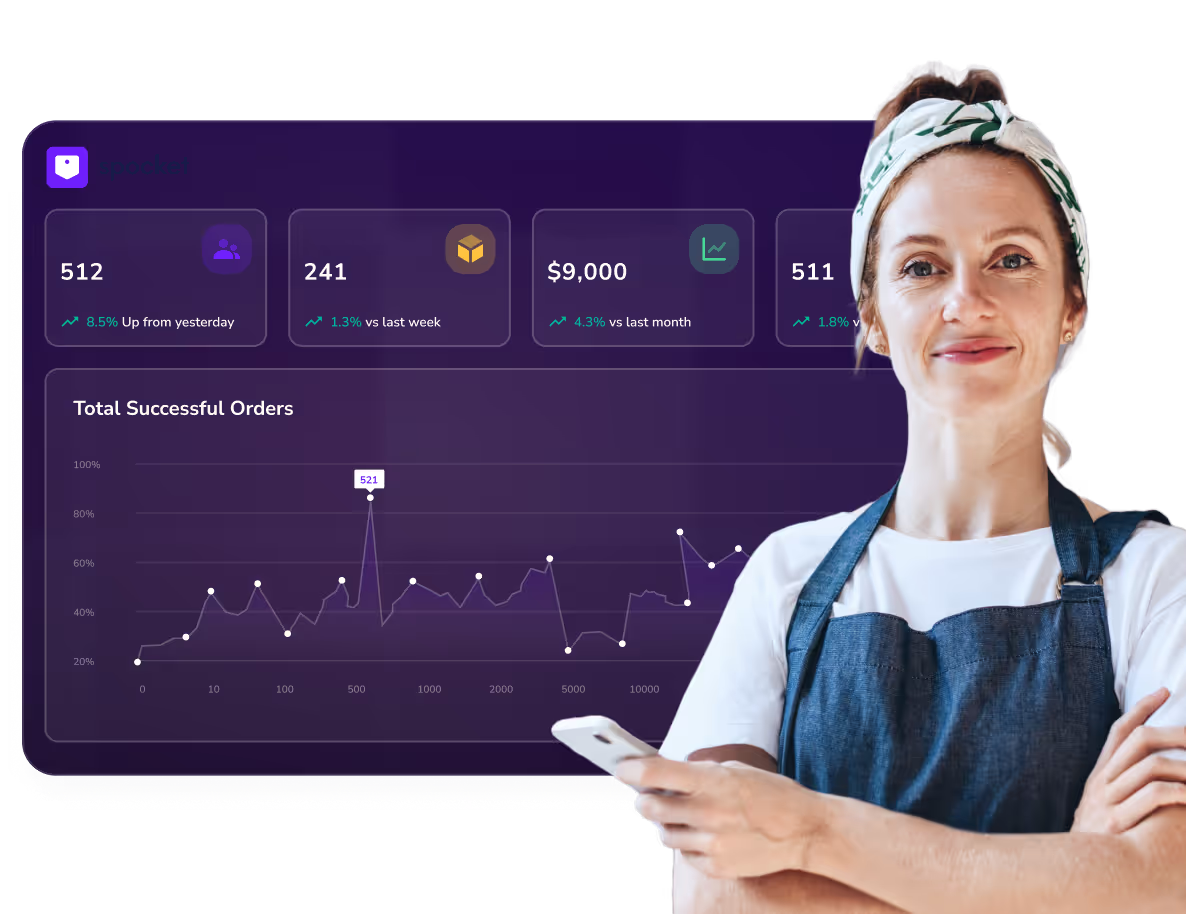Printful is a popular print-on-demand (POD) dropshipping platform, that allows businesses to sell custom-designed products without inventory. The POD market is expected to reach $12.96 billion by 2025, driven by increasing demand for personalized products and sustainable fulfillment. However, Printful’s higher product costs, slower shipping times, and limited product scope can reduce profit margins and scalability.
For entrepreneurs seeking faster shipping, a broader product catalog, and higher profit margins, Spocket is a better alternative. Unlike Printful, which focuses solely on custom products with longer production times, Spocket offers ready-to-sell, high-quality items from US & EU suppliers, ensuring 2-7 day delivery and better supplier pricing.
While Printful is ideal for niche POD businesses, Spocket is the better choice for sellers looking for faster fulfillment, diverse product options, and a competitive edge in dropshipping.
What is Printful?
Printful is a print-on-demand (POD) dropshipping platform that allows businesses to sell custom-designed products without managing inventory. Unlike traditional dropshipping, where sellers source ready-made products, Printful enables users to print unique designs on apparel, accessories, home decor, and more, which are only produced when an order is placed.

Printful integrates with major e-commerce platforms like Shopify, WooCommerce, Etsy, and Amazon, automating the entire process from product customization to order fulfillment. It is widely used by entrepreneurs, artists, and brands looking to monetize custom merchandise without upfront costs.
Features of Printful
1. Wide Range of Custom Products
- Offers t-shirts, hoodies, mugs, phone cases, posters, tote bags, and more.
- Allows full customization with high-quality printing methods like embroidery, direct-to-garment (DTG), and sublimation.
2. Automated Order Fulfillment
- Handles printing, packaging, and shipping without manual input.
- Syncs seamlessly with Shopify, WooCommerce, Etsy, Amazon, and eBay.
3. Global Warehousing & Faster Shipping
- Fulfillment centers in the US, Canada, Mexico, Europe, and Australia.
- Reduces shipping times for international orders compared to AliExpress-based suppliers.
4. Branding & White Labeling
- Offers custom labels, packaging inserts, and branded packing slips for businesses looking to create a unique brand identity.
5. No Upfront Costs
- Printful operates on a pay-per-order model, meaning sellers only pay when a sale is made, eliminating inventory risks.
6. On-Demand Production for Sustainability
- Reduces overproduction and waste by only printing products when an order is placed, making it eco-friendly.
Pros and Cons of Printful
Printful is a leading print-on-demand (POD) dropshipping platform, offering a hassle-free way to sell custom-designed products without holding inventory. However, like any platform, it has its strengths and limitations.
Below is a breakdown of the pros and cons of using Printful.
Pros of Printful
1. No Upfront Inventory Costs
Products are printed and shipped only when an order is placed, eliminating the need for bulk inventory purchases.
2. High-Quality Products & Printing Methods
Printful offers premium-quality apparel, accessories, and home decor with advanced printing options like direct-to-garment (DTG), embroidery, and sublimation.
3. Automated Order Fulfillment
Seamlessly integrates with Shopify, WooCommerce, Etsy, Amazon, and other e-commerce platforms, allowing automatic order processing and fulfillment.
4. Global Warehousing for Faster Shipping
Printful has fulfillment centers in the US, Canada, Europe, and Australia, reducing shipping times compared to traditional AliExpress suppliers.
5. Custom Branding Options
Offers custom labels, branded packaging, and packing inserts, helping sellers establish a unique brand identity.
6. No Minimum Order Requirement
Unlike wholesale suppliers, sellers can sell one item at a time, making it a low-risk business model.
7. Eco-Friendly On-Demand Model
Products are only made when ordered, reducing overproduction and waste, and making Printful a sustainable choice.
Cons of Printful
1. Higher Product Costs
Printful’s pricing is higher than that of other POD providers and standard dropshipping platforms like Spocket, which can lead to lower profit margins.
2. Longer Production & Shipping Times
Unlike ready-made dropshipping products, Printful requires additional production time before shipping, leading to longer order fulfillment periods.
3. Limited Product Variety
Printful is focused solely on customizable products, whereas platforms like Spocket provide a broader range of high-quality, ready-to-ship items.
4. No Bulk Discounts
Printful does not offer significant price reductions for bulk orders, which can limit scalability for large-scale businesses.
5. No Free Plan for Branding Features
While the platform is free, custom branding features require additional costs, increasing overhead expenses for new sellers.
6. Limited Supplier Diversity
Unlike dropshipping platforms like Spocket or CJ Dropshipping, Printful only offers its own production and fulfillment services, limiting supplier options.
How Does Printful Work?
Printful is a print-on-demand (POD) dropshipping platform that allows businesses to sell custom-designed products without managing inventory. The platform automates product printing, order fulfillment, and shipping, making it a hands-off solution for e-commerce entrepreneurs.
Here’s a step-by-step breakdown of how Printful works:
Step 1: Create an Online Store and Connect Printful
- Sign up for Printful and integrate it with your Shopify, WooCommerce, Etsy, Amazon, eBay, or other e-commerce platforms.
- Printful syncs with your store, allowing automatic order processing.
Step 2: Choose and Customize Products
- Select from Printful’s catalog of t-shirts, hoodies, mugs, phone cases, posters, and more.
- Upload your custom designs, logos, or artwork using Printful’s mockup generator.
- Adjust placement, colors, and printing techniques (DTG, embroidery, sublimation).
Step 3: Publish Products to Your Store
- Once designed, publish products directly to your online store with pricing, descriptions, and images.
- Customers can browse and purchase the products like any other e-commerce store.
Step 4: Printful Automatically Fulfills Orders
- When a customer places an order, Printful automatically receives it, prints the design, and prepares it for shipping.
- The order is sent to one of Printful’s fulfillment centers in the US, Canada, Europe, or Australia for production.
Step 5: Printful Ships Directly to Customers
- After production, Printful packs and ships the order under your brand name.
- Shipping times vary based on location and Printful’s fulfillment center availability.
Step 6: Track Orders & Manage Customer Service
- Printful provides real-time tracking so customers can monitor their shipments.
- Sellers can manage returns and refunds directly through the platform.
Key Benefits of Printful’s Process
- No Upfront Inventory Costs: Products are only printed when an order is placed.
- Seamless Store Integration: Works with Shopify, WooCommerce, Etsy, and other platforms.
- Automated Order Fulfillment: No manual processing is required.
- Brand Customization: Custom labels, packing slips, and branding options.
- On-Demand Production: Reduces waste and ensures sustainability.
Is Printful Still Relevant in 2025?
Yes, Printful will remain relevant in 2025, but its suitability depends on business goals, costs, and market trends. The print-on-demand (POD) industry is projected to reach $12.96 billion, driven by the demand for customized and eco-friendly products. Printful continues to offer seamless automation, premium printing, and e-commerce integrations, making it a strong choice for POD businesses.
However, rising competition and fulfillment challenges have led many sellers to explore alternatives with faster shipping and higher profit margins. Platforms like Spocket provide ready-to-sell products from US & EU suppliers, ensuring shorter delivery times and better pricing for traditional dropshipping businesses.
Why Printful is Still Relevant in 2025
- Growing POD Market: The custom product market is expanding, making Printful valuable for niche sellers.
- Seamless E-commerce Integration: Works with Shopify, WooCommerce, Etsy, Amazon, and more.
- Premium Printing & Branding Options: Offers DTG, embroidery, and custom packaging for brand-focused businesses.
- No Upfront Inventory Costs: Sellers only pay when an order is placed, reducing financial risk.
- Sustainability Advantage: On-demand production minimizes waste and overproduction.
Challenges Printful Faces in 2025
- Higher Costs & Lower Profit Margins: Printful’s pricing is higher than traditional dropshipping, affecting earnings.
- Longer Fulfillment & Shipping Times: Custom production adds delays, making it less competitive than ready-to-ship products.
- Limited Product Scope: Focuses solely on customized merchandise, unlike platforms offering diverse dropshipping products.
- Growing Competition from Alternatives: Spocket, CJ Dropshipping, and AliDrop offer faster shipping, wholesale pricing, and supplier variety.
Choose Spocket as a Better Alternative to Printful
While Printful is a popular print-on-demand (POD) platform, it comes with higher costs, longer production times, and lower profit margins. For entrepreneurs looking for faster shipping, better supplier variety, and higher profitability, Spocket is a superior alternative.
Why Spocket is a Better Choice than Printful
- Faster Shipping: Printful takes several days for production before shipping, while Spocket ships in 2-7 days from US & EU-based suppliers.
- Higher Profit Margins: Printful’s production costs are higher, reducing seller profits, whereas Spocket offers wholesale pricing with better margins.
- More Product Variety: Spocket provides a diverse catalog of ready-to-sell items, unlike Printful, which focuses only on custom merchandise.
- No Production Delays: Printful requires manufacturing time for every order, while Spocket’s products are pre-made and shipped immediately.
- Branded Invoicing: Spocket allows sellers to add custom branding and invoices, helping build a stronger brand identity.
- Seamless E-commerce Integration: Both platforms integrate with Shopify, WooCommerce, Etsy, and BigCommerce, but Spocket’s faster fulfillment enhances customer satisfaction.
When to Choose Spocket Over Printful
- If you want faster shipping from US & EU suppliers.
- If you prefer higher profit margins with wholesale pricing.
- If you need a broader product selection beyond print-on-demand items.
- If you want to avoid long production wait times.
What to Look for When Choosing Alternatives to Printful?
When considering alternatives to Printful, it’s important to evaluate key factors that impact profitability, shipping times, product quality, and business scalability.
Printful is known for print-on-demand customization, but its higher costs, longer production times, and lower profit margins push many sellers to look for better options.
Key Factors to Consider in a Printful Alternative
1. Faster Shipping & Global Fulfillment
- Printful’s production process adds extra time before shipping, which can delay orders.
- Look for platforms with US & EU-based suppliers to ensure 2-7 day delivery instead of waiting weeks for fulfillment.
- Alternatives like Spocket and CJ Dropshipping offer faster shipping from local warehouses.
2. Product Variety Beyond POD
- Printful focuses only on print-on-demand items, limiting the product range.
- If you want ready-to-sell dropshipping products, consider platforms like Spocket that offer fashion, electronics, home goods, and beauty products.
3. Profit Margins & Pricing Structure
- Printful’s higher base prices reduce profitability.
- Choose alternatives that offer wholesale pricing, lower fees, or one-time payment options (like AliDrop) to increase profit margins.
4. Seamless E-Commerce Integration
- Printful integrates with Shopify, WooCommerce, Etsy, and Amazon, so alternatives should offer similar or more integrations for a smooth transition.
- Platforms like Spocket and SaleHoo provide one-click product imports and direct store syncing.
5. Branding & Customization Options
- If brand identity is important, look for custom labeling, branded packaging, and white-label options.
- Spocket offers branded invoicing, while CJ Dropshipping provides custom packaging services.
6. Automation & Order Fulfillment
- A good alternative to Printful should have automated order processing, real-time inventory updates, and hands-free fulfillment.
- Spocket, CJ Dropshipping, and AliDrop excel in automated order syncing and tracking.
7. Cost & Subscription Fees
- Printful has no upfront costs, but custom branding and premium features come with extra charges.
- Some alternatives offer free plans (Spocket) or one-time payment options (AliDrop) to reduce long-term costs.
Conclusion
Printful remains a leading print-on-demand platform, offering custom product creation, seamless e-commerce integrations, and automated fulfillment. It is an excellent option for businesses focused on branding and personalized merchandise, with no upfront inventory costs and sustainable on-demand production.
However, higher product costs, longer production times, and limited product variety can make it less competitive for sellers who prioritize faster shipping and higher profit margins. Entrepreneurs looking for ready-to-sell dropshipping products with shorter delivery times and better pricing may find alternatives like Spocket a better fit.
Ultimately, the choice depends on business goals Printful is ideal for customized POD businesses, while Spocket and similar platforms provide greater product diversity and faster fulfillment for scalable e-commerce success.







































